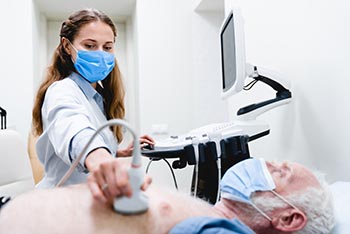Oneida Health
What is Transthoracic Echocardiography
 Transthoracic echocardiograms (TTE) is a type of echocardiography performed by a sonographer.
Transthoracic echocardiograms (TTE) is a type of echocardiography performed by a sonographer.
How the Test is Performed
- Electrodes are placed on the chest.
- A special gel is applied in the areas where the transducer will be used.
- The sonographer places the transducer on your chest. This small tool emits sound waves and receives the echoes of those sound waves as they reflect off your body’s internal structures.
- Sound waves are converted into electrical impulses.
- The electrical impulses are converted into detailed moving images of the heart (or blood vessels).
- After the test is complete, the information is given to your cardiologist for review.
In some patients, body tissues or organs may block a clear view of the heart. The sonographer may inject a contrast dye to improve visualization. If this does not work, then a transesophageal echocardiogram may be necessary (see below).
Transesophageal Echocardiogram (TEE):
Transesophageal echocardiograms are much less common than TTEs. They are typically used when good visualization cannot be obtained via TTE. The patient is generally advised not to eat or drink anything other than water for six hours prior to the test. Electrodes are placed on the patient’s chest and are connected to an electrocardiograph monitor. Blood pressure cuffs and a pulse oximeter will be attached as well. The patient will receive a local anesthetic to their throat and an IV will be administered. The doctor will pass a thin, flexible endoscope down your throat. This procedure will not hurt and will not interfere with breathing. A transducer at the end of the endoscope will be adjusted so several images can be taken of your heart. The procedure will last about an hour and a half. Patients can return to work in about 24 hours after the procedure.